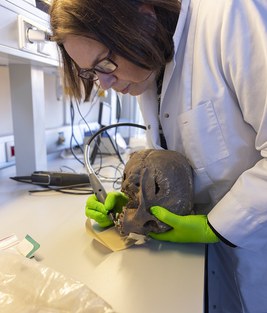UGent research reveals oldest skull and skull fragment in Flanders
(28-06-2024) During the Contact Day Archaeology of the Province of East Flanders on Friday 28 June, it was announced that the oldest skull and skull fragment of Flanders have been discovered in Ename.
A new exhibition on heritage care and the heritage of Ename will open at the provincial Heritage Site Ename on 6 July. For this reason, researchers from the Department of Archaeology were asked to collaborate on the study of prehistoric finds found during the construction of a reservoir in 2003. These include pottery, stone tools and human remains from the Neolithic period (c. 4300-2000 BC). This is the period of the first farmers in Flanders.
New information about the first farmers

"The study of the human skeletal remains shows that at least nine individuals are involved, both men, women and children, including a man whose skull is the most complete one excavated so far in Flanders from the prehistoric Scheldt Valley," says professor Isabelle de Groote. "These are healthy people who ate a diet consisting of agricultural crops and domesticated animals such as beef, but who also still ate wild food sources. We see no signs of stress or malnutrition, something that is by contrast often seen in Neolithic farmers."
Multiple unique finds
"Due to the generally acidic and dry subsoil in Flanders, few skeletal remains of humans and animals from prehistoric times have been preserved. This is why the finds from Ename are particularly interesting and unique," explains Professor Philippe Crombé. "These finds prove that there is still great potential in the Flemish river valleys for discovering organic remains from prehistoric times, which can give us more insights into the way of life of our ancestors."
"Based on the well-preserved pottery, the traces of use on the material and the preserved human remains, this is probably a settlement of the first farmers that lay along the banks of the Scheldt," adds researcher Dimitri Teetaert. Exactly how these human remains ended up at the site in Ename is not entirely clear, but the most obvious hypothesis is that they came from disturbed graves laid out on or near a settlement. The latter is confirmed by the many traces of use on the pottery and stone utensils.
Top find on display from 6 July

For more information, visit www.erfgoedsiteEname.be.
Photos: copyright Provincie Oost-Vlaanderen
